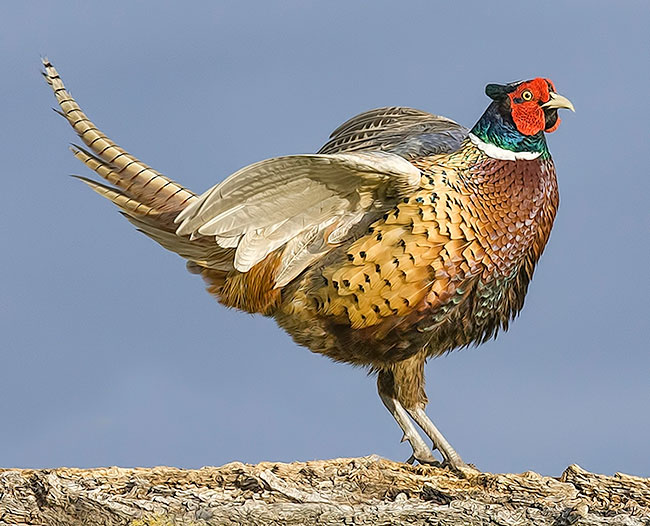Introduced to the U.S. from Asia, the Ring-necked Pheasant has become established in many areas, and is still being raised in captivity and released in others. Ring-necked Pheasants have a high reproductive output, and are also known to lay their eggs in the nests of many other birds.
The territories of male Ring-necked Pheasants are only defended until the females are done nesting, and groups of pheasants are often seen during the fall and winter. Pheasants have large clutches of eggs to make up for their high mortality rate. Few pheasants live to be more than three years old.
Length: 21-35 inches
Wing span: 31 inches
On this page
Description of the Ring-necked Pheasant
BREEDING MALE
The Ring-necked Pheasant is a game bird with a long, pointed tail and rounded wings with barred flight feathers.
Males are a coppery-brown color with a gray rump, red face, greenish neck, white collar, and very long, brownish, barred tail.
Female
Females are mostly brownish with black markings on the upperparts and flanks and a shorter tail.
Seasonal change in appearance
None.
Juvenile
Juveniles are similar to females.
Habitat
Ring-necked Pheasants are found in agricultural areas, fence lines, and brushy edges.
Diet
Ring-necked Pheasants eat a varied diet of grain, seeds, berries, insects and worms.
Behavior
Ring-necked Pheasants forage on the ground, sometimes scratching with their feet.
Range
The Ring-necked Pheasant is native to Asia and was introduced to North America. It now occurs across much of the mid to upper latitudes of the U.S. Its North American population has declined slightly in recent decades.
Fun Facts
Ring-necked Pheasants sometimes lay eggs in the nest of another female, resulting in extra large clutches.
Because of its popularity as a game bird, many pheasants are raised and released each year.
Ring-necked Pheasants are the state birds of South Dakota.
Vocalizations
The call is a loud, rough, two-note crow.
Similar Species
- No other game bird has such a long, narrow tail.
Nesting
The nest is a depression in the ground lined with grasses and leaves, usually in dense cover.
Number: Usually lay 10-12 eggs.
Color: Olive.
Incubation and fledging:
The young hatch at about 23-28 days, and leave the nest almost immediately, though continuing to associate with the female for some time.


